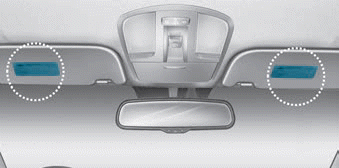Hyundai Ioniq: With Tire Mobility Kit (TMK) - Type A / Checking the tire inflation pressure
1. After driving approximately 4~6 miles (7~10 km or about 10 minutes), stop at a safe location.

2. Connect the filling hose (3) directly into the compressor.

3. Connect the other end of the filling hose (3) directly into the tire valve.
4. Plug the compressor power cord (4) into the vehicle power outlet.
5. Adjust the tire inflation pressure to the recommended tire inflation. With the ignition switched on, proceed as follows.
- To increase the inflation pressure:
Switch on the compressor. To check the current inflation pressure setting, briefly
switch off the compressor.
- To reduce the inflation pressure:
Press the button (9) on the compressor.
Information
The pressure gauge may show higher than actual reading when the compressor is running. To get an accurate tire pressure, the compressor needs to be turned off.
CAUTION
When you use the Tire Mobility Kit including sealant not approved by HYUNDAI, the tire pressure sensors may be damaged by sealant.
The sealant on the tire pressure sensor and wheel should be removed when you replace the tire with a new one and inspect the tire pressure sensors at an authorized dealer.
WARNING
The tire inflation pressure must be at least 32 psi (220 kPa). If it is not, do not continue driving. Call for road side service or towing.
Information
When reinstalling the repaired or replaced tire and wheel on the vehicle, tighten the wheel lug nut to 79~94 lbf·ft (11~13 kgf·m).
 Using the Tire Mobility Kit
Using the Tire Mobility Kit
CAUTION
Detach the speed restriction label (1) from the sealant bottle (2), and place
it in a highly visible place inside the vehicle such as on the steering wheel to
remind the driver not to drive too fast...
 With Tire Mobility Kit (TMK) - Type B
With Tire Mobility Kit (TMK) - Type B
For safe operation, carefully read and follow the instructions in this manual
before use.
(1) Compressor
(2) Sealant bottle
The Tire Mobility Kit is a temporary fix to the tire and the tire should be inspected
by an authorized HYUNDAI dealer as soon as possible...
Other information:
Hyundai Ioniq (AE) 2017-2025 Owner's Manual: Emission Control System
The emission control system of your vehicle is covered by a written limited warranty. Please see the warranty information contained in the Owner's Handbook & Warranty Information booklet in your vehicle. Your vehicle is equipped with an emission control system to meet all applicable emission regulations...
Hyundai Ioniq (AE) 2017-2025 Service Manual: Virtual Engine Sound Speaker. Repair procedures
Removal1.Disconnect the negative(-) battery terminal.2.Remove the front bumper cover.(Refer to Body - "Front Bumper Cover")3.Disconnect the VESS speaker connector (A) and then remove the VESS speaker (B) after loosening mounting bolts.Installation1.After connecting the VESS connectors, install the VESS speaker...
Categories
- Manuals Home
- 1st Generation Ioniq Owners Manual
- 1st Generation Ioniq Service Manual
- Smart Cruise Control System
- Child-Protector Rear Door Locks
- Check Hybrid system, Check Hybrid system. Turn engine Off
- New on site
- Most important about car
Air Bag Warning Labels

Air bag warning labels, required by the U.S. National Highway Traffic Safety Administration (NHTSA), are attached to alert the driver and passengers of potential risks of the air bag system. Be sure to read all of the information about the air bags that are installed on your vehicle in this Owners Manual.
